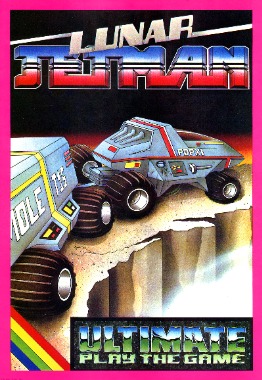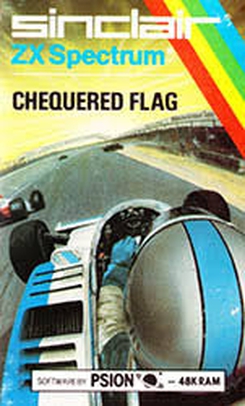
Jet Set Willy is a platform video game originally written by Matthew Smith for the ZX Spectrum home computer. It was published in 1984 by Software Projects and ported to most home computers of the time.

Matthew Smith is a British computer game programmer. He created the games Manic Miner and Jet Set Willy for the ZX Spectrum, released in 1983 and 1984 respectively. Smith left the games industry in 1988 and later moved to the Netherlands. He has since returned to the UK and has worked on some games as well as appearing at conventions and in documentaries.

Sabre Wulf is an action-adventure game released by British video game developer Ultimate Play the Game for the ZX Spectrum home computer in 1984. The player navigates the pith-helmeted Sabreman through a 2D jungle maze while collecting amulet pieces to bypass the guardian at its exit. The player does not receive explicit guidance on how to play and is left to decipher the game's objectives through trial and error. Sabreman moves between the maze's 256 connected screens by touching the border where one screen ends and another begins. Each screen is filled with colourful flora, enemies that spawn at random, and occasional collectibles.

Jetpac is a shooter video game developed and published by Ultimate Play the Game and released for the ZX Spectrum and VIC-20 in 1983 and the BBC Micro in 1984. It is the first game to be released by Ultimate Play the Game, the company which later became Rare. The game follows Jetman as he must rebuild his rocket in order to explore different planets, while simultaneously defending against hostile aliens. It was written by Ultimate co-founder Chris Stamper with graphics designed by his brother, Tim Stamper. Reviewers praised Jetpac's presentation and gameplay, and it won "Game of the Year" at the Golden Joystick Awards in 1983.

3D Monster Maze is a survival horror computer game developed from an idea by J.K. Greye and programmed by Malcolm Evans and released in 1981 for the Sinclair ZX81 platform with the 16 KB memory expansion. The game was initially released by J. K. Greye Software in December 1981 and re-released in 1982 by Evans' own startup, New Generation Software. Rendered using low-resolution character block "graphics", it was one of the first 3D games for a home computer, and one of the first games incorporating typical elements of the genre that would later be termed survival horror.

Underwurlde is a 1984 action-adventure platform video game in the Sabreman series by Ultimate Play the Game for the ZX Spectrum and Commodore 64. The player controls the adventurer Sabreman as he jumps between platforms in a castle and its caverns to find an escape past the exit guardians. Underwurlde features about 600 flip screen areas. Unlike other games of its time, Sabreman is not injured when touched by enemies and is instead knocked backwards. Underwurlde is the second game in the series, between Sabre Wulf and Knight Lore, and released shortly before the latter for the ZX Spectrum in late 1984. Another developer, Firebird, ported the game to the Commodore 64 the next year.

CRL Group plc was a British video game development and publishing company. Originally CRL stood for "Computer Rentals Limited". It was based in King's Yard, London and run by Clem Chambers.

Lunar Jetman is a horizontally scrolling shooter developed and published by Ultimate Play the Game. It was released for the ZX Spectrum in 1983 and later on the BBC Micro. In this sequel to Jetpac, the second instalment of the Jetman series, Jetman has to destroy alien bases whilst simultaneously defending himself, along with Earth, from a hostile alien race.

Atic Atac is an arcade-adventure video game developed and published by Ultimate Play the Game, released for the ZX Spectrum in 1983 and the BBC Micro in 1985. The game takes place within a castle in which the player must seek out the "Golden Key of ACG" by unlocking doors and avoiding enemies. It was Ultimate's second game to require 48K of RAM; most of their previous games for the Spectrum ran on unexpanded 16K models.

Tornado Low Level is a multidirectional flight game developed by Costa Panayi and published in 1984 by the company he co-founded, Vortex Software. The game was released for the ZX Spectrum in 1984, with ports for the Amstrad CPC and Commodore 64 in 1985.

Cauldron is a video game developed and published by British developer Palace Software in 1985 for the ZX Spectrum, Commodore 64, and Amstrad CPC home computers. It contains both platform game and horizontally scrolling shooter sections. Players control a witch who aims to become the "Witch Queen" by defeating an enemy called the "Pumpking".

Cauldron II: The Pumpkin Strikes Back is a video game developed and published by British developer Palace Software as a sequel to their 1985 game Cauldron. The 2D platform game was released in 1986 for the ZX Spectrum, Commodore 64, and Amstrad CPC home computers. Players control a bouncing pumpkin that is on a quest of vengeance against the "Witch Queen". The roles of the two were reversed from the first game, in which the witch defeated a monstrous pumpkin.

Alchemist is an action-adventure game for the ZX Spectrum and released by Imagine Software in 1983. The player controls an alchemist who can shape-shift into a golden eagle.

Deactivators is a 1986 puzzle video game designed by David Bishop and Chris Palmer, developed by Tigress Marketing and System Software, and published by Ariolasoft's action game imprint Reaktor. The player controls bomb disposal robots known as deactivators and must use them to deactivate bombs planted by terrorists in five research complexes. The concept for the game came from a brainstorming session between Bishop and Palmer; its design and development took five to six months to complete. It was released for the Amstrad CPC 464, Commodore 64, and ZX Spectrum platforms in October 1986.

Chequered Flag is a racing video game developed by Psion Software and published by Sinclair Research in 1983. It was the first driving game published for the ZX Spectrum and one of the first computer car simulators.
Bubble Bus Software was a publisher of video game software for home computers in the mid-1980s, founded by Mark Meakins and based in Tonbridge, Kent. Their releases targeted popular home computers of the time, such as the Commodore 64, VIC-20 and ZX Spectrum. Their most notable releases were Starquake and Wizard's Lair, both written by Stephen Crow. Wizard's Lair was notable for its similarity to both Atic Atac and Sabre Wulf.

Alien is a 1984 hybrid strategy/adventure video game developed by Concept Software and published by Argus Press Software for the Commodore 64 and ZX Spectrum, and later ported for the Amstrad CPC in 1985. It is based on the science fiction horror film Alien.

Ace is a combat flight simulator video game published for the Commodore 64, VIC-20, and Plus/4 in 1985 by Cascade Games. It was ported to the Amstrad CPC, Amstrad PCW, Amiga, and ZX Spectrum.

The Rocky Horror Show is a video game, based on the musical of the same name, it was developed and published by CRL Group. It was released for Apple II, Commodore 64, Commodore 128, ZX Spectrum, and Amstrad CPC created by the CRL Group PLC.

ZX Spectrum Next is an 8-bit home computer, initially released in 2017, which is compatible with software and hardware for the 1982 ZX Spectrum. It also has enhanced capabilities. It is intended to appeal to retrocomputing enthusiasts and to "encourage a new generation of bedroom coders", according to project member Jim Bagley.



















